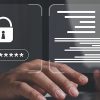Before you invest heavily in a “next-gen” network security solution, ensure that you have your foundational security measures firmly in place. In the past year, nearly one in three businesses experienced a data breach, often due to prevalent oversights such as:
- Weak passwords
- Outdated software
- Inadequate training
- Overly generous user privileges
By sidestepping these pitfalls, you can significantly reduce the appeal of your organization to hackers. In this article, we’ll cover these fundamental aspects of network security and provide tips to safeguard your data from falling into the dark web.
Critical Network Security Oversights
- Weak Passwords
Employees often choose simple passwords for convenience or reuse the same password across accounts, which significantly jeopardizes your organization’s security. A determined hacker can easily bypass weak passwords, and if that password is linked to multiple accounts, the breach can escalate rapidly.
To mitigate this risk, consider implementing the following:
- Develop and enforce robust password policies.
- Educate employees about the dangers of weak passwords and teach them how to create stronger ones — passwords should contain a mix of letters, numbers, and symbols and be updated regularly.
- Update business software to enforce stringent password requirements.
- Use an enterprise password manager for centralized control.
- Implement multi-factor authentication (MFA) that requires additional verification methods to access accounts.
Addressing weak passwords is manageable and requires commitment from leadership to enforce these policies—it’s vital that someone is designated to oversee their implementation.
- Outdated Software
Software update notifications often arrive at inconvenient times, leading many to delay updates. However, outdated software leaves systems vulnerable and invites potential ransomware attacks. Preventative measures include:
- Keeping all software up to date and promptly patching known vulnerabilities.
- Poor Training
Ignoring the human factor in network security can be detrimental. Even with the best technical defenses, a single employee clicking on a malicious attachment can compromise the entire network. Major ransomware incidents have frequently resulted from phishing emails. It’s crucial to equip your employees with the knowledge needed to navigate threats while working remotely or in public areas. Training should include:
- Recognizing and avoiding common threats, such as phishing emails and unsecured networks.
- Regular cybersecurity training sessions for all staff to reinforce the importance of vigilance.
- Clear instructions on whom to contact if they suspect a security breach.
- Excessive Privileges
Granting users more access than necessary poses a significant risk. Excess and unnecessary privileges can lead to insider threats or make it easier for hackers to gain control of sensitive data. Control this risk by:
- Utilizing role-based access controls to restrict access according to job requirements.
- Regularly updating permissions when employees change roles or leave the organization.
- Conducting periodic audits to ensure access rights are properly managed.
Basic Network Security Measures
Effective network security management is vital for protecting your company’s digital assets. Here are some essential steps for those starting from the ground up:
-
Set Up Network Firewalls: Think of firewalls as security personnel for your network, scrutinizing incoming and outgoing data to block harmful traffic. They can be hardware-based for comprehensive network protection or software-based for individual devices.
-
Install Antivirus Software: Equip all workplace devices with credible antivirus and anti-malware solutions to defend against harmful software. Ensure regular updates and scans for optimal protection.
-
Utilize a Virtual Private Network (VPN): For remote workers, VPNs are crucial for encrypting data, especially on unsecured Wi-Fi networks. Look for VPNs that offer strong encryption, a no-log policy, and reliable performance.
-
Implement Encryption: Ensure sensitive data is encrypted both in transit and at rest using tools like end-to-end encrypted emails, file encryption software, and SSL certificates for web security.
- Set Up Multi-Factor Authentication (MFA): MFA adds an extra layer of security by requiring verification beyond just a password, significantly reducing the risk of unauthorized access.
Sustaining Network Security
Once initial security measures are in place, ongoing practices are necessary to maintain a secure network:
-
Network Monitoring: Regularly analyze traffic to identify unusual activity using designated monitoring software.
-
Consistent Software Updates: Regularly update all software and firmware to patch vulnerabilities and enhance security.
-
Equipment Upgrades: Periodically review and upgrade network equipment to align with current security standards.
-
Ongoing Employee Training: Continuous training programs ensure employees are aware of emerging threats and best practices.
-
Regular Security Audits: Routine scans for vulnerabilities help identify and rectify security gaps.
- Limit Network Access: Regularly assess user access controls to confirm that only authorized personnel have access to sensitive information.
Addressing Security Issues in Remote Work
Remote work expands the attack surface for organizations. To mitigate risks, address the following major challenges:
-
Unsecured Personal Devices: Establish BYOD policies that require personal devices to be equipped with updated antivirus software and security measures.
-
Secure Data Transmission: Mandate the use of VPNs to keep data secure and encrypted when sent over potentially insecure home networks.
- Physical Device Security: Implement measures like password locks, disk encryption, and remote wipe capabilities for devices used outside the office to prevent unauthorized access.
By focusing on these basics and ensuring continuous training and monitoring, your organization can build a robust defense against potential cyber threats.






